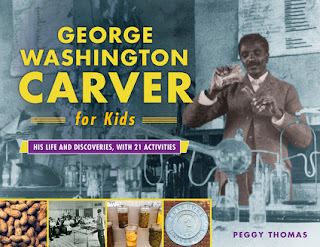Many people don't realize how long it takes to birth a book. Gestation is longer than that of an elephant!
My newest book,
George Washington Carver for Kids and all of its 30,000 or so words, 72 photographs, and 21 activities was one of the faster projects I have worked on. It wasn't as fast as some work-for-hire projects that give you a few weeks to crank out a manuscript, but for me this was writing in the fast lane.
Here is the time line:
October 2016 - I first queried
Chicago Review Press (CRP). Thanks to amazing advice from Nancy I. Sanders, a veteran CRP author, I knew to offer a few topics. The editor responded quickly saying he'd be interested in George W. Carver.
It took me two weeks to crank out a chapter by chapter proposal which included a list of 21 activities, a sample chapter, and marketing connections. Then I waited.
March 2017 - The editor responded asking for a revision to the sample chapter, which I quickly sent in.
April 2017 - I got an offer. While waiting for the contract to come, I made travel plans. I not only needed to see where Carver lived to inform my research, but I needed to start acquiring 72 photographs. The more I took, the fewer I would have to purchase. Hopefully, many would be free.
May 2017 - I had an Ag in the Classroom speaking engagement in Salina, Kansas, so I extended the trip to rent a car and drive to the
George Washington Carver National Monument in Diamond, Missouri. The Park Ranger, Curtis Gregory, is a passionate Carver fan, and proudly showed us their collection of documents. Fran and I wandered the property, visited grave sites, and took photos of the creek he must have splashed in, the wild flowers he would have gathered, and more. The next day we drove to Neosho where Carver went to school. I like to get a sense of the landscape that surrounded a person. Did he walk through woods or fields to get to school? How close was the nearest neighbor? To get a sense of the town we visited the Historical Society and learned about that time period. Then I went home and wrote.
August 2017 Trip to Tuskegee, Al. I had an appointment at the
Tuskegee University Archives. Again, we found more people passionate about Carver. Dana Chandler, the Director of the Archives told us stories, gave us a tour, and fed us everyday. We spent hours reviewing period photos, and wandering around campus taking pictures.
October 2017 - I submitted the manuscript and all the photographs.
November 2017 - The marketing department sent me the lengthy author questionnaire to fill out. Bookstores, media outlets, anyone who could help promote the book.
December 2017 - a sneak peek at the cover art. Do I like it? YES!!
March 2018 - Edits arrived. Since October I had been working on another project, which I had to toss aside to address comments from the editor. The manuscript didn't look too bad. Sometimes a manuscript comes back bloodied with the editor's red ink. You're sure the book won't survive. Revisions continued off and on for a couple of months.
July 2018 -- Revisions in galleys. Now the story looks like a book. Each page has the art work in place, but still there are things that need to be addressed. Sometimes a line has to be taken out to make everything fit on the page, or I have to catch typos. Each time, I try to make sure dates and other content is still accurate.
January 8, 2019 -- Happy Book Birthday! George Washington Carver For Kids is officially available for purchase.
Two years, three months. I think I'll call my new wrinkles "stretch marks" from birthing a book.
Well worth it!!
















